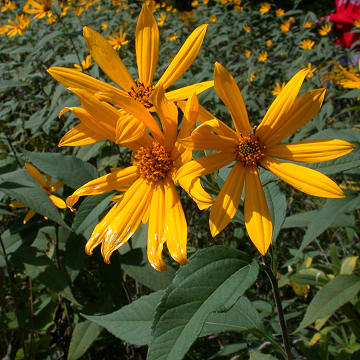

Helianthus tuberosus - (image 1 of 4)
Taxonomy
Family: Asteraceae
Synonymous with H. tomentosus Michx.
Some plants might be confused with H. rigidus (Cass.) Desf. (Prairie Sunflower).
Habitat
Rich, moist soil and disturbed areas in full sun.
Associates
Distribution
Throughout the eastern U.S. and adjacent Canada, west across the Great Plains. Being an important food crop to Native Americans, the natural range may have been altered long ago by the transport of this species by humans.
Morphology
Herbaceous perennial to 3 m, from tuber-bearing rhizomes. Stems stout and more or less spreading-hairy. Leaves opposite below, often becoming alternate on the upper half or two-thirds of the plant, scabrous above, short-hairy below, broadly lanceolate or ovate, the larger ones 4-12 cm wide, serrate, abruptly narrowing to a winged petiole 2-8 cm long. Flowers in a corymbiform inflorescence of many heads; disk florets yellow, to 2.5 cm wide; involucral bracts dark, particularly near the base, narrowly lanceolate, acuminate or subattenuate, not imbricate; rays 10-20, to 4 cm long.
Notes
Flowers late August to early October
Wetland indicator: Facultative
The roots of this species are edible and contain the carbohydrate inulin, which has a lower food value than sugar or starch with a minimal influence on blood sugar. The tubers are crunchy and slightly sweet, similar to water chestnut. Individuals may have difficulty digesting Jerusalem Artichoke so it is recommended that a small quantity be eaten at first.
References
Gleason, Henry A. and A. Cronquist. 1991. Manual of Vascular Plants of
Northeastern United States and Adjacent Canada. Second Ed.
The New York Botanical Garden. Bronx, NY
Swink, F. and G. Wilhelm. 1994. Plants of the Chicago Region.
Indiana Academy of Science. The Morton Arboretum. Lisle, Illinois.
|
Michael Hough © 2009 |